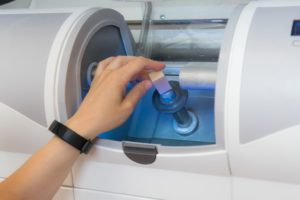
Traditional vs. modern. This age-old conflict puts the old-fashioned method against new technology. When it comes to dental crowns, the traditional way of fabricating these restorations is sending the case to a dental lab, but nowadays, advanced technology is available called CEREC or same-day crowns.
Which one is better? Which method is superior? Keep reading to learn more about each option and determine which one you’d like to use for your crown.
Lab-Created Crowns
For traditional crowns, the patient must have at least two appointments. During the first, the tooth is prepared (i.e., reduced or treated for decay or damage), impressions are taken, and a temporary crown is placed. After the dental lab creates the crown, it is shipped to the dentist’s office, where it is bonded onto the tooth for a seamless appearance.
Advantages
While lab crowns tend to take longer to fabricate, they can be made from a wider variety of materials. For example, molar crowns may require ceramic bonded to metal for more durability, and using a lab allows for some flexibility and customization that you may not get with in-office CEREC crowns.
Disadvantages
Although lab-created crowns can be precise, they require at least a couple of weeks to make, leaving you to deal with an ill-fitting temporary crown in the meantime. Additionally, if the crown does not fit properly, it must be shipped back to the lab, prolonging the process even more.
CEREC Crowns
As an alternative to crowns produced in an official dental lab, CEREC crowns are designed and fabricated right in the office, using digital technology. In fact, CEREC stands for Chairside Economical Restoration of Esthetic Ceramic, meaning that most of the process is completed while you are in the dentist’s chair or at least still in the office.
Advantages
Instead of having to leave with a temporary crown and wait for a few weeks for the customized crown, you typically wait for only about an hour. This same-day option saves you time overall because you do not have to return for a separate appointment. In addition, if any major adjustments need to be made to the crown, your dentist can perform them on their in-house milling machine, rather than send the crown back to the dental lab for correction.
Disadvantages
As technology and the skillsets of dentists continue to improve for CEREC crowns, the cons of this treatment continue to diminish. In some cases, lab-fabricated crowns may result in a more precise, natural-looking product, but by and large, restorations created in-office resemble those made in the lab.
Which Type of Crown Wins?
The truth is that, regardless of the type of fabrication method your dentist recommends or uses for your specific case, you can rely on this restoration to resemble a real tooth as well as function and fit exceptionally well. When you work with a dentist who takes advantage of CEREC technology, you can have access to the option that is best for you! In either case, you can smile with pride knowing that your teeth look beautiful and are complete once again.
About the Practice
At Pioneer Greens Dentistry, Dr. Chris Haag and Dr. Claire Haag use CEREC technology to produce crowns in our Lincoln office. With decades of experience and advanced training, they stay abreast of innovations and bring them back to our local patients to make their dental experience better and faster. If you have questions about CEREC crowns, you may call our office at 402-483-7502 or visit our Contact Us page here.
